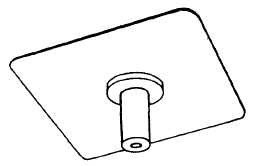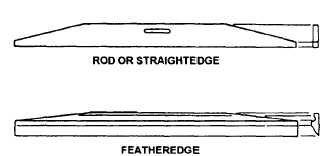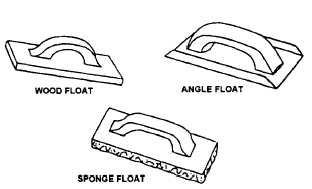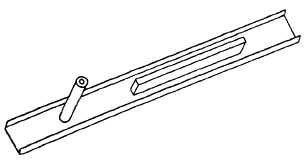Figure 7-13.—Plasterting hawk.
Figure 7-14.—Plastering floats.
of plaster. The pointing trowel, 2 inches wide and about
10 inches long, is used in places where the rectangular
trowel doesn’t fit. The margin trowel is a smaller trowel,
similar to the pointing trowel, but with a square, rather
than a pointed, end. The angle trowel is used for
finishing comer angles formed by adjoining right-angle
plaster surfaces.
Hawk
The hawk (fig. 7-13) is a square, lightweight sheet-
metal platform with a vertical central handle, used for
carrying mortar from the mortar board to the place
where it is to be applied. The plaster is then removed
from the hawk with the trowel. The size of a hawk varies
from a 10- to a 14-inch square. A hawk can be made in
the field from many different available materials.
Float
Afloat is glided over the surface of the plaster to fill
voids and hollows, to level bumps left by previous
operations, and to impart a texture to the surface. The
most common types of float are shown in figure 7-14.
The wood float has a wood blade 4 to 5 inches wide and
about 10 inches long. The angle float has a stainless steel
Figure 7-15.-Straightedge and featheredge.
Figure 7-16.-Darby.
or aluminum blade. The sponge float is faced with foam
rubber or plastic, intended to attain a certain surface
texture.
In addition to the floats just mentioned, other floats
are also used in plasterwork. A carpet float is similar to
a sponge float, but faced with a layer of carpet material.
A cork float is faced with cork.
Straight and Feather Edges
The rod or straightedge consists of a wood or
lightweight metal blade 6 inches wide and 4 to 8 feet
long (see fig. 7-15). This is the first tool used in leveling
and straightening applied plaster between the grounds.
A wood rod has a slot for a handle cut near the center of
the blade. A metal rod usually has a shaped handle
running the length of the blade.
The featheredge (fig. 7-15) is similar to the rod
except that the blade tapers to a sharp edge. It is used to
cut in inside corners and to shape sharp, straight lines at
outside comers where walls intersect.
Darby
The darby (fig. 7-16) is, in effect, a float with an
extra long (3 1/2 to 4 foot) blade, equipped with handles
for two-handed manipulation. It is used for further
straightening of the base coat, after rodding is
7-13








